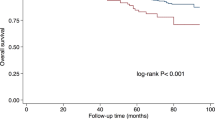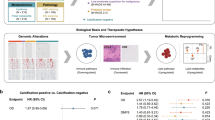Abstract
Background and purpose
Limited information is available regarding the correlations between mammographic calcifications and the epidemiological features of patients with breast cancer living different lifestyles in Western China. Thus, this study aimed to investigate the relationship between mammographic calcifications and the epidemiological characteristics of female patients with breast cancer in Western China.
Methods
This was a hospital-based, retrospective, multi-center epidemiological study of patients with breast cancer. Using the Western China Clinical Cooperation Group (WCCCG) database, we obtained the records of 7317 patients (with mammographic data) diagnosed with breast cancer between March 2011 and June 2016. These patients were divided into Groups I (mass alone) and II (mass combined with calcification), and their clinical and pathological data were compared.
Results
A total of 4211 patients were enrolled in Group I, and 3106 patients were enrolled in Group II. The tumors in Group II were more likely to be larger (P < 0.0001), higher grade (P = 0.0029), estrogen receptor (ER)+/progesterone receptor (PR)− (P = 0.0319), and human epidermal growth factor receptor 2 (HER-2)-positive (P < 0.0001), and to have axillary lymph node metastasis (P = 0.0033) than those in Group I. Regarding treatment, patients in Group II were more likely to have undergone chemotherapy (P = 0.0108) and anti-HER2 therapy (P = 0.0102), whereas patients in Group I were more likely to have undergone endocrine therapy (P < 0.0001).
Conclusions
In conclusion, mammographic calcifications in tumors were associated with distinct clinicopathologic characteristics and aggressive treatments.
Similar content being viewed by others
Abbreviations
- ER:
-
Estrogen receptor
- PR:
-
Progesterone receptor
- HER-2:
-
Human epidermal growth factor receptor 2
- CT:
-
Computed tomography
- MRI:
-
Magnetic resonance imaging
References
Miller KD, Siegel RL, Lin CC, Mariotto AB, Kramer JL, Rowland JH, Stein KD, Alteri R, Jemal A (2016) Cancer treatment and survivorship statistics, 2016. CA Cancer J Clin 66(4):271–289. doi:10.3322/caac.21349
Fan L, Zheng Y, Yu KD, Liu GY, Wu J, Lu JS, Shen KW, Shen ZZ, Shao ZM (2009) Breast cancer in a transitional society over 18 years: trends and present status in Shanghai, China. Breast Cancer Res Treat 117(2):409–416. doi:10.1007/s10549-008-0303-z
Nystrom L, Andersson I, Bjurstam N, Frisell J, Nordenskjold B, Rutqvist LE (2002) Long-term effects of mammography screening: updated overview of the Swedish randomised trials. Lancet 359(9310):909–919. doi:10.1016/S0140-6736(02)08020-0
Fan L, Strasser-Weippl K, Li JJ, St Louis J, Finkelstein DM, Yu KD, Chen WQ, Shao ZM, Goss PE (2014) Breast cancer in China. Lancet Oncol 15(7):e279–e289. doi:10.1016/S1470-2045(13)70567-9
Tabar L, Chen HH, Duffy SW, Yen MF, Chiang CF, Dean PB, Smith RA (2000) A novel method for prediction of long-term outcome of women with T1a, T1b, and 10–14 mm invasive breast cancers: a prospective study. Lancet 355(9202):429–433
Gajdos C, Tartter PI, Bleiweiss IJ, Hermann G, de Csepel J, Estabrook A, Rademaker AW (2002) Mammographic appearance of nonpalpable breast cancer reflects pathologic characteristics. Ann Surg 235(2):246–251
Evans AJ, Pinder SE, Ellis IO, Sibbering DM, Elston CW, Poller DN, Wilson AR (1994) Correlations between the mammographic features of ductal carcinoma in situ (DCIS) and C-erbB-2 oncogene expression. Nottingham Breast Team. Clin Radiol 49(8):559–562
Seo BK, Pisano ED, Kuzimak CM, Koomen M, Pavic D, Lee Y, Cole EB, Lee J (2006) Correlation of HER-2/neu overexpression with mammography and age distribution in primary breast carcinomas. Acad Radiol 13(10):1211–1218. doi:10.1016/j.acra.2006.06.015
Wang X, Chao L, Chen L, Tian B, Ma G, Zang Y, Hua M, Sun J (2008) Correlation of mammographic calcifications with Her-2/neu overexpression in primary breast carcinomas. J Digit Imaging 21(2):170–176. doi:10.1007/s10278-008-9105-4
Karamouzis MV, Likaki-Karatza E, Ravazoula P, Badra FA, Koukouras D, Tzorakoleftherakis E, Papavassiliou AG, Kalofonos HP (2002) Non-palpable breast carcinomas: correlation of mammographically detected malignant-appearing microcalcifications and molecular prognostic factors. Int J Cancer 102(1):86–90. doi:10.1002/ijc.10654
Tabar L, Tony Chen HH, Amy Yen MF, Tot T, Tung TH, Chen LS, Chiu YH, Duffy SW, Smith RA (2004) Mammographic tumor features can predict long-term outcomes reliably in women with 1-14-mm invasive breast carcinoma. Cancer 101(8):1745–1759. doi:10.1002/cncr.20582
Jiang L, Ma T, Moran MS, Kong X, Li X, Haffty BG, Yang Q (2011) Mammographic features are associated with clinicopathological characteristics in invasive breast cancer. Anticancer Res 31(6):2327–2334
Shin HJ, Kim HH, Huh MO, Kim MJ, Yi A, Kim H, Son BH, Ahn SH (2011) Correlation between mammographic and sonographic findings and prognostic factors in patients with node-negative invasive breast cancer. Br J Radiol 84(997):19–30. doi:10.1259/bjr/92960562
Palka I, Ormandi K, Gaal S, Boda K, Kahan Z (2007) Casting-type calcifications on the mammogram suggest a higher probability of early relapse and death among high-risk breast cancer patients. Acta Oncol 46(8):1178–1183. doi:10.1080/02841860701373611
Naseem M, Murray J, Hilton JF, Karamchandani J, Muradali D, Faragalla H, Polenz C, Han D, Bell DC, Brezden-Masley C (2015) Mammographic microcalcifications and breast cancer tumorigenesis: a radiologic-pathologic analysis. BMC Cancer 15:307. doi:10.1186/s12885-015-1312-z
Wang K, Ren Y, Li H, Zheng K, Jiang J, Zou T, Ma B, Li H, Liu Q, Ou J, Wang L, Wei W, He J, Ren G (2016) Comparison of clinicopathological features and treatments between young (</=40 years) and older (> 40 years) female breast cancer patients in West China: a retrospective, epidemiological, multicenter, case only study. PLoS ONE 11(3):e0152312. doi:10.1371/journal.pone.0152312
Li T, Mello-Thoms C, Brennan PC (2016) Descriptive epidemiology of breast cancer in China: incidence, mortality, survival and prevalence. Breast Cancer Res Treat 159(3):395–406. doi:10.1007/s10549-016-3947-0
Boyd NF, Guo H, Martin LJ, Sun L, Stone J, Fishell E, Jong RA, Hislop G, Chiarelli A, Minkin S, Yaffe MJ (2007) Mammographic density and the risk and detection of breast cancer. N Engl J Med 356(3):227–236. doi:10.1056/NEJMoa062790
Aminololama-Shakeri S, Abbey CK, Gazi P, Prionas ND, Nosratieh A, Li CS, Boone JM, Lindfors KK (2016) Differentiation of ductal carcinoma in situ from benign micro-calcifications by dedicated breast computed tomography. Eur J Radiol 85(1):297–303. doi:10.1016/j.ejrad.2015.09.020
Farshid G, Sullivan T, Downey P, Gill PG, Pieterse S (2011) Independent predictors of breast malignancy in screen-detected microcalcifications: biopsy results in 2545 cases. Br J Cancer 105(11):1669–1675. doi:10.1038/bjc.2011.466
James JJ, Evans AJ, Pinder SE, Macmillan RD, Wilson AR, Ellis IO (2003) Is the presence of mammographic comedo calcification really a prognostic factor for small screen-detected invasive breast cancers? Clin Radiol 58(1):54–62
Nyante SJ, Lee SS, Benefield TS, Hoots TN, Henderson LM (2017) The association between mammographic calcifications and breast cancer prognostic factors in a population-based registry cohort. Cancer 123(2):219–227. doi:10.1002/cncr.30281
Evans AJ, Pinder SE, James JJ, Ellis IO, Cornford E (2006) Is mammographic spiculation an independent, good prognostic factor in screening-detected invasive breast cancer? AJR Am J Roentgenol 187(5):1377–1380. doi:10.2214/AJR.05.0725
Dunnwald LK, Rossing MA, Li CI (2007) Hormone receptor status, tumor characteristics, and prognosis: a prospective cohort of breast cancer patients. Breast Cancer Res BCR 9(1):R6. doi:10.1186/bcr1639
Schiavon G, Smith IE (2014) Status of adjuvant endocrine therapy for breast cancer. Breast Cancer Res BCR 16(2):206
Gutierrez C, Schiff R (2011) HER2: biology, detection, and clinical implications. Arch Pathol Lab Med 135(1):55–62. doi:10.1043/2010-0454-RAR.1
Slamon DJ, Clark GM, Wong SG, Levin WJ, Ullrich A, McGuire WL (1987) Human breast cancer: correlation of relapse and survival with amplification of the HER-2/neu oncogene. Science 235(4785):177–182
Toikkanen S, Helin H, Isola J, Joensuu H (1992) Prognostic significance of HER-2 oncoprotein expression in breast cancer: a 30-year follow-up. J Clin Oncol 10(7):1044–1048. doi:10.1200/jco.1992.10.7.1044
Martin M, Sanchez-Rovira P, Munoz M, Baena-Canada JM, Mel JR, Margeli M, Ramos M, Martinez E, Garcia-Saenz JA, Casado A, Jaen AM, Gonzalez-Farre X, Escudero MJ, Rodriguez-Martin C, Carrasco E, Geicam (2011) Pegylated liposomal doxorubicin in combination with cyclophosphamide and trastuzumab in HER2-positive metastatic breast cancer patients: efficacy and cardiac safety from the GEICAM/2004-05 study. Ann Oncol 22(12):2591–2596. doi:10.1093/annonc/mdr024
Andersson Y, Frisell J, Sylvan M, de Boniface J, Bergkvist L (2010) Breast cancer survival in relation to the metastatic tumor burden in axillary lymph nodes. J Clin Oncol 28(17):2868–2873. doi:10.1200/JCO.2009.24.5001
Wallgren A, Bonetti M, Gelber RD, Goldhirsch A, Castiglione-Gertsch M, Holmberg SB, Lindtner J, Thurlimann B, Fey M, Werner ID, Forbes JF, Price K, Coates AS, Collins J, International Breast Cancer Study Group Trials I VII (2003) Risk factors for locoregional recurrence among breast cancer patients: results from International Breast Cancer Study Group Trials I through VII. J Clin Oncol 21(7):1205–1213. doi:10.1200/JCO.2003.03.130
Bianchini G, Balko JM, Mayer IA, Sanders ME, Gianni L (2016) Triple-negative breast cancer: challenges and opportunities of a heterogeneous disease. Nat Rev Clin Oncol 13(11):674–690. doi:10.1038/nrclinonc.2016.66
Barnes DM, Camplejohn RS (1996) P53, apoptosis, and breast cancer. J Mammary Gland Biol Neoplasia 1(2):163–175
Lemoine NR (1994) Molecular biology of breast cancer. Ann Oncol 5(Suppl 4):31–37
Acknowledgements
This work was supported by a grant from the National Natural Science Foundation of China (NSFC Grant No. 81202090 to Ke Zheng).
Author information
Authors and Affiliations
Corresponding authors
Ethics declarations
Conflicts of interest
The authors declare that they have no conflicts of interest.
Rights and permissions
About this article
Cite this article
Zheng, K., Tan, JX., Li, F. et al. Relationship between mammographic calcifications and the clinicopathologic characteristics of breast cancer in Western China: a retrospective multi-center study of 7317 female patients. Breast Cancer Res Treat 166, 569–582 (2017). https://doi.org/10.1007/s10549-017-4406-2
Received:
Accepted:
Published:
Issue Date:
DOI: https://doi.org/10.1007/s10549-017-4406-2




